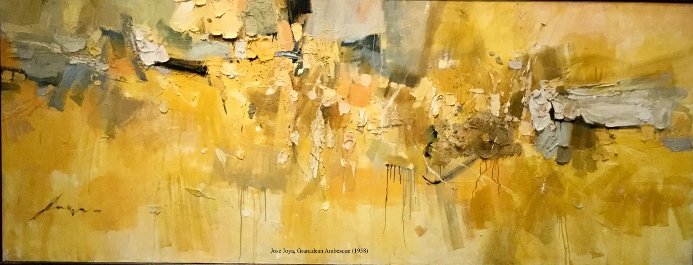
Jose Joya’s Granadean Arabesque (1958)
The brightest color that the human eye can see, yellow is color
between orange and green in the visible light spectrum. Associated
with sunshine and brightness, as well as happiness and optimism, it
is the color of ripeness in bananas and mangoes, of the Beatles’
Yellow Submarine, the “smiley” face emoji, or Van Gogh’s
starry nights and sunflowers. And it is the color of graduation time
in UP Diliman’s rows of blooming sunflowers.
Yellow Ambiguities celebrates the color yellow in all its hues and
shades at the Ateneo Art Gallery, Areté, Ateneo de Manila University
until 05 January 2020.
Jose Joya’s Granadean Arabesque (1958) immediately greets the viewers
and sets the tone of the exhibit, with its thick broad strokes of
impasto and sand in celebration of tropical radiance.
Mellow yellow complexity
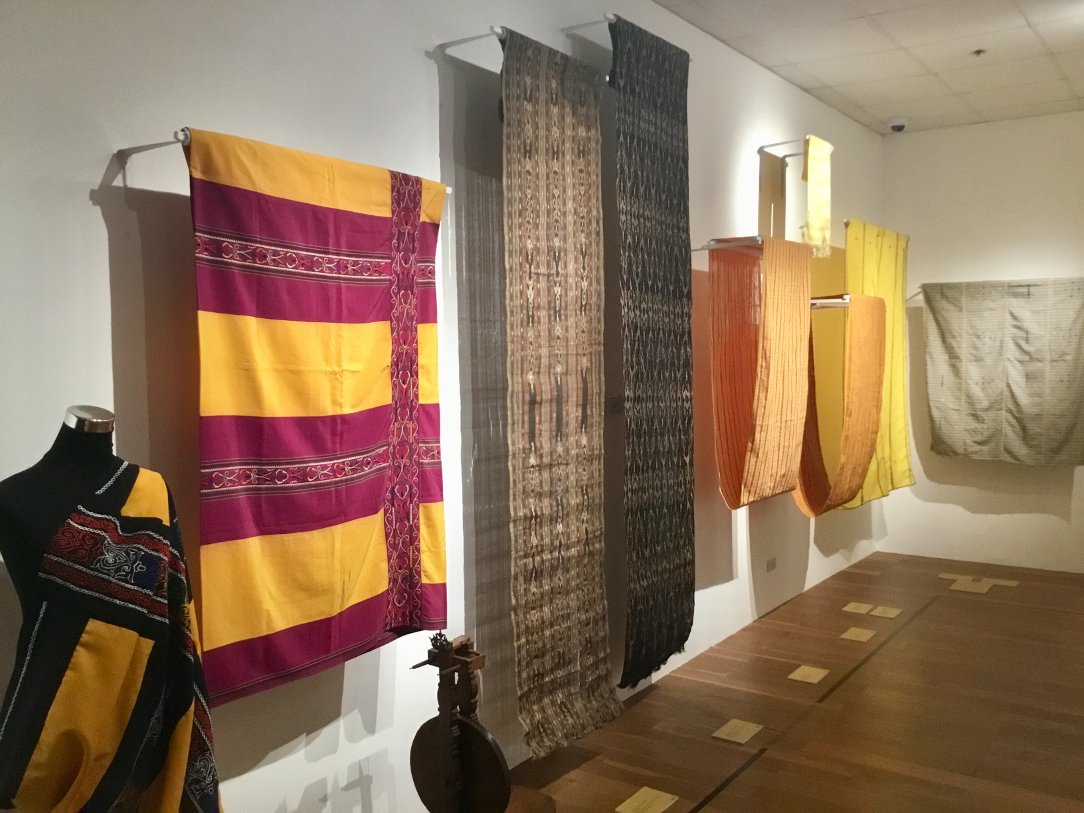
Various woven textiles
With some 90 artworks on display, the exhibition explores the
complexity of yellow as seen in “its materials, culture, art
history, and concept.” Divided into five sections — Forms and
Ideas, Tropics and Heat, Illness and Struggle, Halos and
Illuminations, and Properties and Surfaces — the exhibit presents
how yellow is used in a variety of media such as plastic vines,
feathers, collage, pencils, archival pigment print, photographs, gold
ornaments and hand-woven textiles, and an assemblage that refers to
that “little patch of yellow” in Vermeer’s painting,
View
of Delft
.
The heat is on
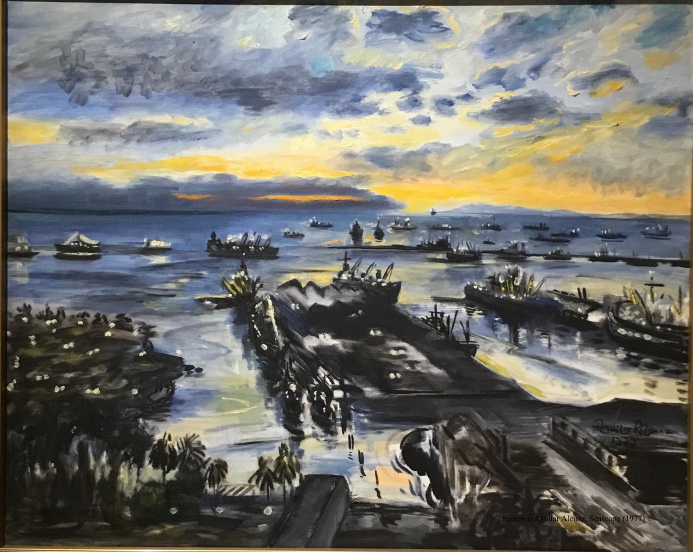
Federico Aguilar Alcuaz, Seascape (1977)
In the section Tropics and Heat, life in tropical intensity starts
with Federico Aguilar Alcuaz,
Seascape (1977) in black and deep blues
with dawn breaking in yellow streaks of sunlight. The idylls of rural
life, so romanticized, leads us to Diosdado Lorenzo’s
The Farmer’s
House
(1958) or even Amorsolo’s Preparing a Noon Day Meal Under a
Mango Tree
(1941). Eating on the go in the filthy streets of Manila
is seen in Daniel Coquilla’s
AristoCart (1995), amidst signs and
symbols in MM Yu’s
Pantone Yellow (2019) and the presence of
mom-and-pop stores everywhere by Antonio Austria,
Sari-Sari Store
(1965). Urban heat and humidity accelerates in Jeepneys (1951) by
Vicente Manansala. Life in the city ends with a night of drunken
stupor in
Last Order (1994) by Jeho Bitancor. The tropical spell is
broken with Edgar Talusan Fernandez,
The Year to Remember (1983), a
thick yellow blanket crumpled on the ground with yellow ribbons
hanging over it, a reference to the Aquino assassination in 1983,
still unsolved to this day. In recent times, Manny Montelibano’s
Uncertainty at the Beach -Temperature (2018), a video installation
looped with Duterte’s rambling speech punctured with profanities. It
forms a grating soundscape, in contrast to Areté’s quietness.
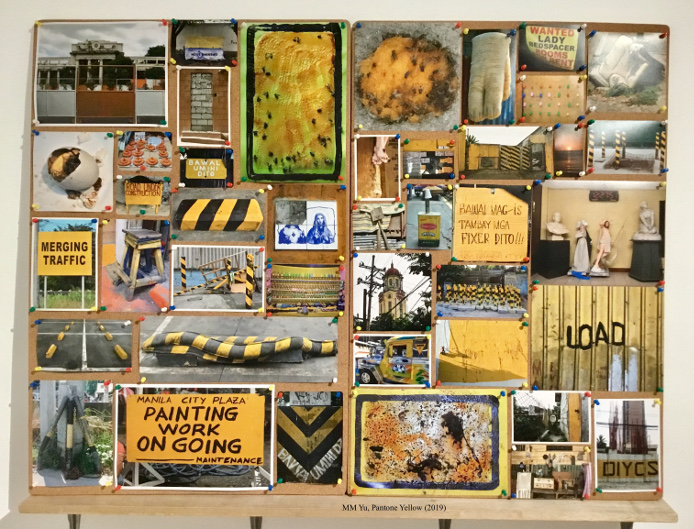
MM Yu’s Pantone Yellow (2019)
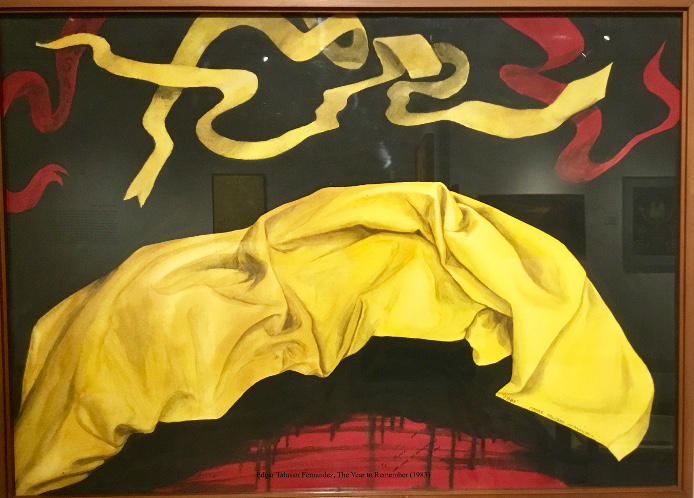
Edgar Talusan Fernandez, The Year to Remember (1983)
Natural sources
Abundant in the natural world, minerals and botanical plants are the
source of natural dyes and pigments for yellow. As such, it suggests
blossoming and ripeness; also of pallor and decay. Yellow ochre (and
red) from clay is one of the earliest pigments used in art; the
Lascaux Caves in France is full of Paleolithic paintings of large
animals such as bisons, bulls, and horses painted in yellow,
estimated to be 20,000 years old.
In the Philippines, pre-Spanish gold ornaments had been used as part
of an ancient burial practice. It is believed that gold death mask
prevents the entry of evil spirits. Such masks have been excavated in
Oton, Iloilo and Butuan, Agusan del Norte where gold was once
abundant.
Yellow is also reflected in the traditional colors of woven fabrics,
dyed with turmeric and lemongrass, such as Mangyan and Itneg textiles
or the Maranao malong included in the exhibition, reflecting the
country’s rich culture of weaving.
Divine light
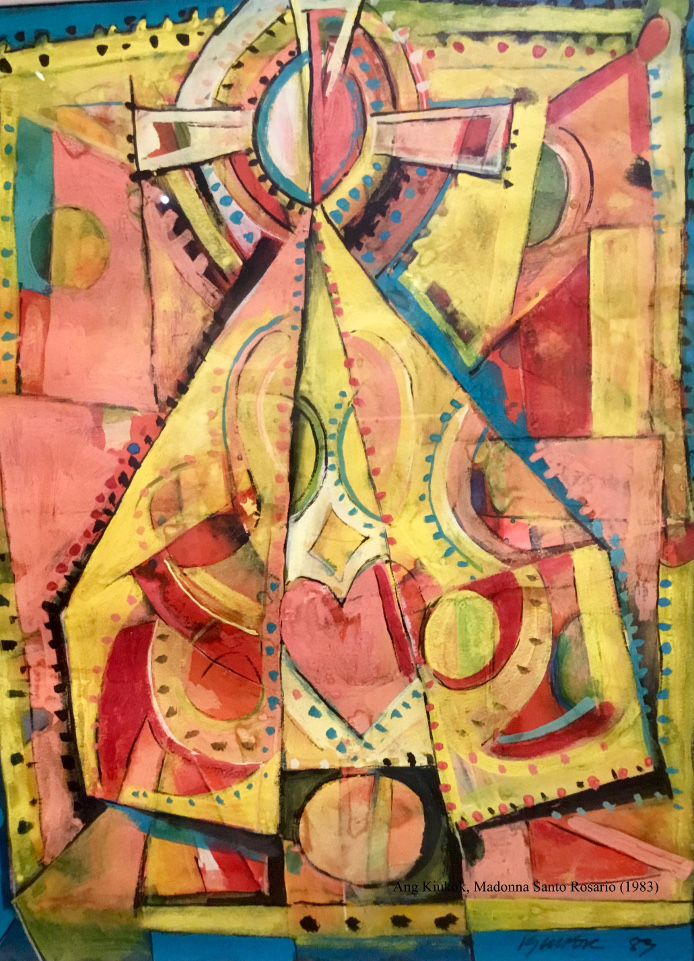
Ang Kiukok’s Madonna-Santo Rosario (1983)
Halos and illuminations in yellow have been used to depict gods,
saints, and divine beings to separate them from mere mortals. The
exhibit explores how the color yellow is reflected in the country’s
religious culture during the Spanish colonial period and how
contemporary artists incorporate such narrative and history into
their works.
Evoking light and vibrancy, Galo B. Ocampo’s Brown Madonna (1938) and
Ang Kiukok’s
Madonna-Santo Rosario (1983) carry the luminosity of
yellow in full force; Edgar Talusan Fernandez’
Sining Kalayaan
(1987/1997) places a yellow orb behind the nation as Mother Freedom
in a battle between evil vs. good. And Anton del Castillo’s
State of
Nothingness
(2006), oil on gold leaf panel resembling Byzantine
icons, pays homage to ordinary Filipinos.
Beyond yellow ‘s association in the country’s political history, and
its recent denigration to “dilawan” (as synonymous to
those who espouse critical thinking or liberalism), the exhibition
forces us to rethink and reframe the color yellow for what is —
light and life — the source of vital energy encapsulated in the sun
rising for another new dawn.
